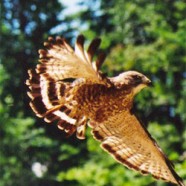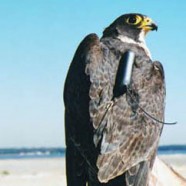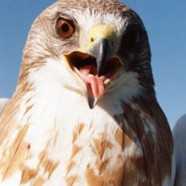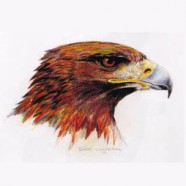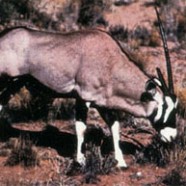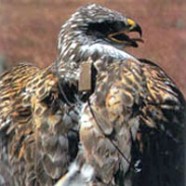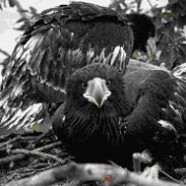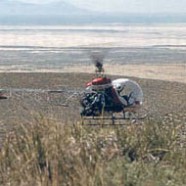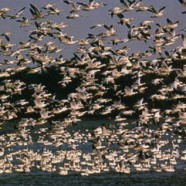Wintering area DDE source to migratory white-faced ibis revealed by satellite telemetry and prey sampling
Earthspan principals led a cooperative study to identify the source(s) of DDT-related contamination still plaguing a northern Nevada population of white-faced ibis many years after use of the pesticide was banned in the United States. The white-faced ibis (Plegadis chihi) is a long-legged wading bird that feeds primarily on invertebrates in wetlands and irrigated croplands. It is a highly social colonial nester and often forages in large aggregations. Due to restricted nesting habitat and potential vulnerability to pesticides, the species is listed by the U.S. Fish and Wildlife Service as a...
Read MoreBroad-winged hawk: Movements and habitat association during migration and wintering periods
Problem/Background Modern organophosphate insecticides are short-lived in the environment. These insecticides are toxic to raptors, but they are unlikely to be detected in animal blood or tissue unless the animals are sampled soon after exposure. Researchers postulate that pesticide exposures, and habitat alteration, in their wintering areas in Central and South America may be adversely affecting broad-winged hawk (Buteo platypterus, BWHA) populations, and those of other neotropical migrants. However, it is unknown whether broad-winged hawks concentrate in certain areas in their winter...
Read MoreSummary of Final Report: Study of Peregrine Falcons Wintering on the Gulf Coast of Mexico
Study of Peregrine Falcons Wintering on the Gulf Coast of Mexico
Read MoreSwainson’s Hawk: Scientific Research Rescues Species Before Threatened or Endangered Status Listing is Needed
Problem/Background The Swainson’s Hawk (Buteo swainsonii, SWHA) is listed as a species of concern by five states and the Bureau of Land Management, and as a special emphasis species by the U.S. Forest Service. Nesting population declines was reported over much of the SWHA range in the early 1990s. With no obvious reason for this decline, scientists postulated that problems along migration routes or on wintering areas were responsible. In 1995 and 1996, we monitored Swainson’s hawk distribution on and off military installations in the western U.S., where their numbers had been diminishing...
Read MoreA Study of The Golden Eagle in Mexico
Selected Passages from the Final Report to Proyecto ARA A.C. Introduction Mexico’s national bird, the golden eagle (Aquila chrysaetos), is classified as “in danger” in Article 9 of the Federal Hunting Law (SEDUE 1984) and Ramos (1986) classifies the population as declining, primarily due to decreases in habitat quality. Environmental pollution (particularly pesticides), direct persecution, and illegal trade are all thought to play a part in the decline (Ramos 1986). Although some information exists about the natural history of golden eagles in the southwestern United States of America,...
Read MoreSatellite Tracking Oryx
Accomplishments White Sands Missile Range, New Mexico White Sands Missile Range (WSMR) is the military’s largest all-overland test range in the Western Hemisphere and encompasses 2.2 million acres, which can be extended to 4 million acres (total) by including adjacent federal land holdings. WSMR houses the U.S. Army Research, Development, Test, and Evaluation (RDT&E) Command for weapons and space systems and components.Within WSMR are the San Andreas National Wildlife Refuge, White Sands National Monument (National Park Service), and Jordana Experimental Range (U.S. Department of...
Read MoreSatellite Tracking Ferruginous Hawks
Hill Airforce Base, Utah Hill AFB Information: Hill AFB is home of the 338th Fighter Wing and 419th Fighter Wing: both are F-16 Fighting Falcon units. Hill AFB also provides maintenance facilities for C-130 aircraft. Approximately 1 million acres is directly controlled by Hill AFB including a core area of 6,690 acres
Read MoreSteller’s Sea Eagle Reseach In Russia
Problem/Background At present, the world’s population of Steller’s sea eagles (Haliaeetus albicilla, SSE) appears to be stable and not endangered; however, this species is listed as a Bird to Watch. Its breeding range is located within remote, restricted areas in Russia – areas where access can be achieved only by air or sea. Indeed, it is likely that the very remoteness of these areas has protected the Steller’s sea eagle from large-scale human interference, and in-depth scientific scrutiny. The Steller’s sea eagle is the largest of all the sea eagles, weighing between 5 and 9 kg...
Read MoreSatellite Tracking Feral Horses and Pronghorn Antelope
Dugway Proving Ground, Utah Dugway Proving Ground (DPG) encompasses 1,300 square miles and houses the U.S. Army RDT&E Command’s Chemical, Biological, and Radiological Weapons School, as well as a U.S. Air Force Flight Test Center. We successfully tracked and monitored via satellite Pronghorn (a big game species) and wild horses. Military land managers must provide habitat for and minimize environmental disturbance to these species. Our system provided information about the movements of these animals remotely, without impacting military activities. Otherwise, the same data would...
Read MoreSatellite Tracking White Pelicans and White-faced Ibis
Naval Air Station Fallon / Stillwater NWR, Nevada Flocking birds are prevalent in the vicinity of NASF, which is situated adjacent to two major wetlands in arid Western Nevada.
Read More
